HOW TO STORE VEGETABLES
ARTICHOKES (globe): in the salad drawer of the fridge. Choose artichokes that are not marred by dry brown patches at the tips of the leaves.
The French favour the large artichokes which need 45-50 minutes in simmering water before they are cooked and are normally served with vinaigrette into which the individual leaves are dipped. Only the flesh at the base of the leaves can be eaten, and the choke (hairy bit in the middle) must be removed.
The Italians, one the other hand, prefer tiny ones which they braise with herbs and eat whole. As the outer leaves are too tough to eat whole, about half of the leaves must be removed before cooking, and the tips of the remaining ones cut off.
Artichoke botttoms (fonds) are the disc-shaped bit of flesh out of which the leaves and the choke (the hairy bit) spring; artichoke hearts (coeurs) are the whole innner part with all the tough leaves removed.
French: artichauts; Italian: carciofi; German: Artischocke. |

|
ARTICHOKES (Jerusalem): in the salad drawer of the fridge. Will keep about 10 days.
They are not related to globe artichokes although were thought to taste like them. They belong to the sunflower family and "Jerusalem" is said to be a corruption of the Italian word for sunflower girasole (turn to the sun). They are usually either reddish or whitish.
A winter vegetable. Knobbly and fiddly to peel - although modern varieties are a lot less knobbly that they used to be. They disclour when peeled, so should be cooked immendiately or kept in water with lemon juice until one is ready to use them. They take about 15 minutes to cook in boiling water. Also excellent roast or sautéed, or raw, sliced thinly as a salad. After boiling they are a dirty white - not a very instagrammable vegetable.
Notorious for causing flatulence, much more than beans, but worth it for the taste. It is said one can build up a tolerance by eating them little and often.
French: topinambour; German: Topinambur or Erdartischocke.
|
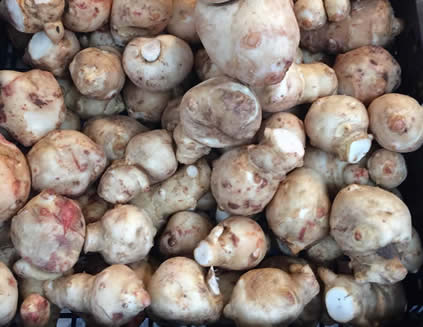
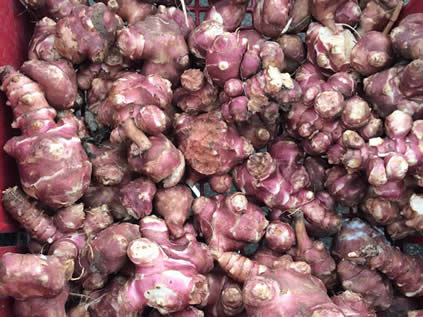
|
AUBERGINES (eggplant): in the salad drawer of the fridge. Eat within 3-4 days or before they start losing their sheen and going soft and wrinkly.
Many recipes suggest that, before being cooked, aubergines should be cut up and salted to draw out the bitter juices. This may well be necessary for some aubergine varieties grown in hot climates (although Harold Magee claims that salting merely masks the bitterness and does not eliminate it). But the hot-house variety from Holland that is sold in the UK is hardly bitter at all. However, salting does stop aubergines from sopping up too much oil when they are fried. Cut them into chunks, put them in a colander or sieve, sprinkle salt generously over them and leave them for an hour. Then wash then chunks well to get rid of the salt and squeeze them in your hands to get rid of as much water as possible.
French, German: aubergine; Italian: melanzane; Spanish: berenjena; Greek: melitzana; Hindi: brinjal; Turkish: patlıcan |
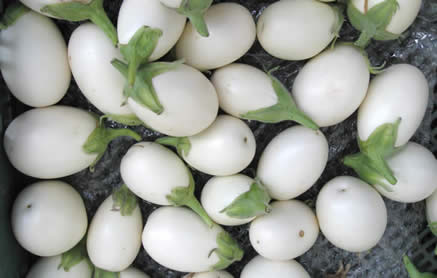
White aubergines. One sees how they got their
American name of eggplant. |
ASPARAGUS: standing in a glass of water, or in a cold part of the fridge. The taste of asparagus deteriorates quickly, so the sooner it can be eaten after cutting the better. When buying, avoid stalks that show any sign of wrinkling. Break rather than cut off the bottom part of the stalks - they will break naturally at the point where they stop being too tough to eat. White asparagus is more fibrous than green and needs to be peeled – a tedious job.
French: asperges; Italian: asparagi; Spanish: espárragos; German: Spargel.
|
 |
AVOCADOES: avocadoes bought ripe are almost inevitably bruised as any pressure affects them. So it is best to buy avocadoes while they are still hard and ripen them at home (2-5 days). Very unripe ones feel woody and brittle; ones nearer to being ripe have a fuller feel. In nature avocadoes do not begin to ripen until they fall from the tree (or are picked) and they ripen best at room temperature. Putting them in a paper bag or in a bowl with other ripe fruit helps. Never put unripe avocadoes in the fridge or they will go black. Once ripe, however, they can be stored briefly in the fridge.
French: poire avocat; German: Avocado; Spanish: aguacates |
|
BEANS (green): in the fridge, in the salad compartment. Will keep 3-5 days, but the fresher the better. As soon as the beans are cooked, coat them with a little olive oil or butter, to keep them fresh and moist. If dressing cooked beans with lemon juice or vinegar, do so only at the last moment as the acid dulls the colour of the beans.
French: haricots verts; Italian: fagiolini; German: grüne Bohnen; Spanish: judias verdes
BROAD BEANS: the younger and fresher they are, the better the taste. When they are very young, the pods can be chopped up and eaten as well. Frozen broad beans, which are usually picked young and frozen within hours, are good and often better than old fresh ones.
Many modern recipes call for the skins of the beans to be removed. This is unnecessary for really fresh broad beans (picked within 24 hours of being cooked) which have delicious silky skins, or for little young ones whose skins are still green in colour (frozen ones usually are OK). But the skins of old stale beans are hard and not very palatable. It is easiest to peel them after they have been cooked, but even so it is fussy work. If you are going to eat the skins, do not salt the water in which the beans are cooked, as this makes the skins go hard.
French: fèves; German: Saubohnen; Italian: fave; Spanish: habas
|
|
BEANS (dried): somewhere dry, and preferably dark (in an opaque packet or in a cupboard). Keep an eye on them, though: they may be harbouring weevil eggs.
Dried beans normally need at least eight hours soaking before cooking (although this can be speeded up by blanching them before soaking). Adding a teaspoon or two of bicarbonate of soda to the soaking water will reduce cooking time by softening the beans. When the beans are ready to cook, bringing them to the boil for five minutes and then discarding that water may reduce their flatulant effect. Some dried beans, especially red ones, also have a poisonous element in them which can be neutralised by 5-10 minutes fast boiling. Otherwise beans benefit from being cooked as slowly as possible. Never add salt to the cooking water, as it inhibits softening. Note: black-eyed beans (actually a relative of peas) do not need soaking before cooking; but start them in cold water and bring them gradually to a simmer, as this enables the water to penetrate to the inside of the beans more quickly. For most recipes requiring cooked beans, tinned ones will do quite well. |
|
BROCCOLI: in the fridge. Eat within 2-3 days. So long as it hasn’t started going yellow, it can be refreshed by putting the heads or florets in cold water for an hour before cooking.
Broccoli heads disintegrate if boiled for more than about five minutes and will also go mushy if bicarbonate of soda is added to the cooking water (whereas for vegetables like green beans a pinch added to the boiling water will help keep them green). Before cooking, cut off as much of the stalk as possible, as the stalk takes longer to cook than the heads and will still be hard when the heads are mushy.
Italian: broccoli; German: Brokkoli; Spanish: brócoli; French: brocoli |
 |
BRUSSELS SPROUTS: in the fridge. Brussels sprouts, like all the cabbage family, taste stronger (and more like institutional food) the longer they are cooked. So they should be cooked as briefly as possible, and deep crosses should be cut in their bottoms to reduce cooking time. It is not necessary to remove the green outer leaves, which are in fact delicious.
French: choux de Bruxelles; German: Rosenkohl |
|
CABBAGE (green), spring greens etc: in the fridge. Eat within 2-3 days. If it is beginning to wilt, chop it and put it in cold water for half an hour before cooking and it will revive miraculously.
CABBAGE (white or red): in the fridge. If whole, it will keep for weeks. Red cabbage should always be cooked with an acidic ingredient like vinegar to stop it losing its colour.
French: choux; German: Kohl; Hindi: ghobi, bandh gobi |
|
CARROTS: in the fridge. Eat within 2-3 days before they start going soft. Even if they are well scrubbed supermarket carrots, it is better to peel or scrape them as the outer layer can be bitter. Avoid very large carrots which can have a woody core. Carrots do not freeze well, as they go mushy.
French: carottes; German: Möhren; Italian: carote |
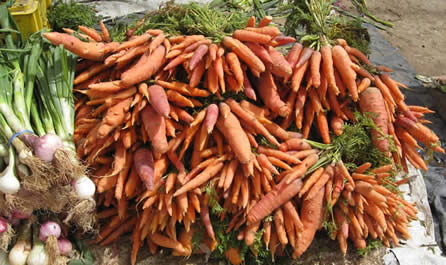 |
CELERY: in the fridge in the salad drawer. It will start to lose its crispness after 2-3 days, but can be refreshed by standing it in a glass of cold water. Wrapping it in tin foil will also help keep it fresh.
French: celeri; German: Sellerie; Italian: sedano |
|
CHARD (or Swiss chard or spinach beet): sprinkle water on them and put in an open plastic bag in a cool place. Do not keep too long. The leaves cook more quickly than the stalks so it is best to put the stalks on to cook first and add the leaves after a few minutes.
French: bettes; Italian: bietola. |
 |
CHILLI PEPPERS: in the fridge. The hottest parts of the chilli are the seeds and more especially the placenta, the palish membrane on which the seeds are growing.
German: Chili; Italian: peperoncini; Hindi: lal mirch;
|
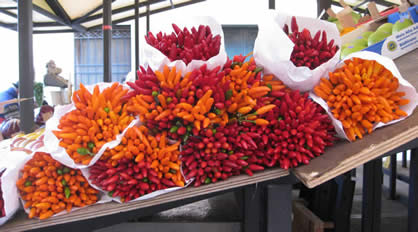 |
CHICK-PEAS: dry chick-peas should be stored somewhere dry, preferably in a sealed container. Dried chick-peas need a lot of soaking before they are cooked - preferably 24 hours. As for dried beans, adding some bicarbonate of soda to the soaking water helps soften them. Tinned chick-peas are usually good and adiquate for most recipes requiring cooked chick-peas.
French: pois chiche; Italian: ceci; German: Kichererbsen; Spanish: garbanzos; Hindi: chana dhal, gram |
|
COURGETTES: in the salad drawer of the fridge. They go soft after a few days and lose their sweet taste.
French: courgettes; Italian: zucchini; German: Zucchini |
|
CUCUMBER: Ideally in a cool temperature (10-12 dgrees) out of the fridge, as they tend to turn to mush if chilled. But they are better the salad drawer of the fridge than in a warm kitchen, in their shop shrink-wrap and preferably wrapped in a tea-towel to insulate them. Sliced cucumber can be salted to get rid of some of the water they contain - after half an hour or so, rinse out the salt and squeeze or pat them dry. This is said to make them more digestible. If there are visible seeds in the central core, it should be cut out.
French: concombre; German: Gurke; Italian: cetriolo |
|
FENNEL: Florentine or bulbous fennel: in the salad drawer. It can be eaten either raw, thinly sliced in a salad, or cooked. The outer leaves tend to be stringy and should be removed, as should the base and the stalks at the top. Fennel has two sexes: counter-intuitively, the female bulb is slimline and the male bulb more rounded. The latter is sweeter. Bulbous fennel is a variant of the common fennel that grows wild, the leaves and seeds of which are also used in cooking.
French: fenouil de Florence or fenouil doux; German: Fenchel; Italian: finocchio (a word also used to describe a gay man); Spanish: hinojo. |
|
GARLIC: at room temperature and preferably in the dark. Garlic kept in the fridge will last longer, but it will also become milder in taste. If the cloves have developed a green shoot, this should be removed as it affects the taste and apparently some people find the shoots indigestible.
Recipes which involve softening onion and garlic in oil or butter usually suggest putting them in the pan at the same time. But garlic cooks and burns a lot quicker than onions, so should be added when the onions are almost soft.
French: ail (aulx); German: Knoblauch; Italian: aglio; Spanish: ajo; Hindi: lassen |
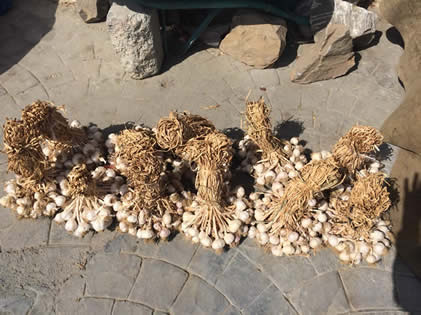
Garlic for sale by the roadside in Morocco |
LETTUCE AND OTHER SIMILAR LEAFY SALADS: in the salad drawer of the fridge loosely wrapped. If a bit wilted, can be revived by placing for half an hour (not more) in cold water. Tear rather than cut salad leaves.
French: laitue; German: Kopfsalat (or just plain
Salat); Spanish: lechuga |
|
MUSHROOMS: in the fridge in a paper bag, never in plastic (undo the cling-film on supermarket packs of mushrooms as soon as possible), as otherwise they will sweat. If they are clean, mushrooms don’t need to be peeled.
French: champignons (de Paris); German: Pilze; Spanish: champiñons |
|
| OLIVES: in the fridge, preferably immersed in brine or oil. |
|
ONIONS AND SHALLOTS: at room temperature (they can also be kept in the fridge). Cooling onions in the fridge for a few hours before cutting them up slows the emission of the pyruvoc acid vapours that make one’s eyes water. Onions will keep for some considerable time and will sweeten and mellow with age, but will eventually start sprouting or rotting. When buying, always choose onions that feel firm.
Onions grown in hot climates tend to be milder than those grown in colder areas. So the big "Spanish" onions are less strong than the smaller common or garden British ones. Red onions are also milder than brown ones. If using raw in salads, they can be made milder still by soaking the slices in cold water for half an hour. When cooked, red onions retain their shape and never quite "melt" in the same way as brown ones.
Shallots are also less pungent and, when finely chopped, are particularly good for adding raw to lentil and bean salads and similar dishes.
French: oignons, echalotes; Italian: cipolle, scalogne; German: Zwiebeln, Schalotten; Spanish: cebollas, chalotes; Hindi: piaz
|
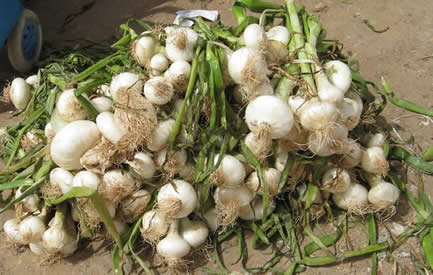
|
PARSLEY AND OTHER LEAFY HERBS: run the bunch of herbs under the cold tap, shake off some of the water, and place in a loosely tied plastic bag in the salad drawer of the fridge. It will keep well for several days. Basil should, however, be kept at room temperature.
Basil and coriander (cilantro in America) lose much of their taste if cooked, so should always be added raw. The taste of basil is particularly fugitive, especially if it is cut across the cells (which is why one is always told to tear basil leaves). If making pesto or any other puree involving basil, the latter should be added at the last moment.
Beware of the fact that green coriander contains a chemical that, for a very small minority of people (probably those with a certain genetic make-up) makes it taste like cat’s piss. |
|
PARSNIPS: in the fridge, not in a plastic bag. Eat within 2-3 days as they become soft quickly.
German: Pastinaken; French: panais
|
|
PEAS: as soon as they are picked, the sugar in peas starts turning to starch. Peas eaten within a few hours of being cooked are sweet and delicious in a way that no starchy shop-bought ones ever are. That is why frozen peas (which are normally frozen almost immediately after they are picked) are often the best bet – although unfortunately freezing does harden the skins.
French: petits pois; German: Erbsen; Italian: piselli;Hindi: mattar
Sugar-snap peas and mangetout: are varieties of peas designed to be picked before the peas are fully formed; the pod is what is eaten. Although they are supposed to be cooked without further preparation, all except the very young ones may have strings, so it is advisable to destring them. They should then be cooked for no more than 3 minutes in salted boiling water. |
|
PEPPERS (CAPSICUMS): in the salad drawer of the fridge. They will start to go wrinkly after a few days. To peel peppers, grill them on all sides until the skin starts to blacken and blister. Put in a sealed plastic bag for half an hour or so. The skin can then be peeled off quite easily.
Red, orange and yellow peppers are fully ripe and, while they taste slightly different, all share a certain sweetness. Green peppers are the unripe version and have a quite different taste, grassy and slightly astringent. So they should not be treated as a substitute for red peppers. They are especially suited to Chinese dishes and also make a good soup. |
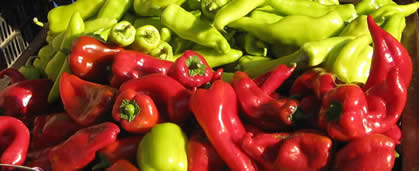
|
POTATOES: in the dark (to discourage them from sprouting), not in a plastic bag. They can be kept in the fridge, although apparently chilling can increase sugar levels which can then convert to acrylamide (a bad thing) if the potatoes are subsequently roasted or fried at high temperature.
Will normally last a couple of weeks at least. New potatoes, however, definitely taste better the fresher they are.
Cut off any green patches under the skin, as these contain a (mild) poison. If potatoes do sprout, the sprouts can be knocked off and they are still perfectly edible, so long as they are not going soft or wrinkled.. Cooked potatoes can be kept for up to a day and then eaten cold in a salad or fried, but their flavour spoils if they are kept longer than that. Potatoes go mushy if frozen.
Don’t puree cooked potatoes in a blender or processor, especially if they are cold, as the action turns the starch in the potatoes into glue.
French: pommes de terre; German: Kartoffeln; Italian: patate; Spanish: patatas; Hindi: alu |
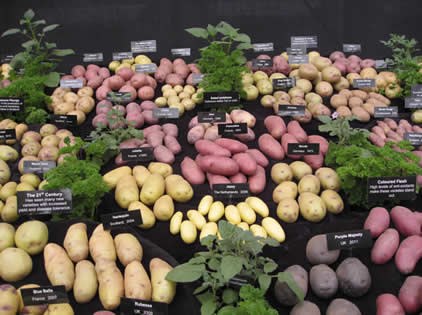 |
SPICES: vary wildly in how long they keep their taste. It is always best to store them in a cool place and whole rather than ground. This is particularly so for coriander seeds which lose much of their aroma within a month or two if ground. Ground cumin, on the other hand, lasts well.
Keeps well: cloves, pepper, nutmeg, fenugreek seeds, whole coriander, cumin, caraway, chilli and paprika (although the latter fades if exposed to light)..
Keeps badly: ground coriander, ginger powder.
|
|
SPINACH: in the fridge, in its cellophane package if it is supermarket spinach (as the bag may have special air inside). If loose, sprinkle with water and keep in an open plastic bag. Loose spinach with long stalks tends to be tastier. Eat within 2-3 days. It can be stored cooked: boil briefly in a small amount of salted water, drain, refresh by pouring cold water over it (or leave it to cool), then use your hands to squeeze all the water out. It can then be kept in the fridge for a day or two in tightly squeezed cricket-sized balls in a plastic bag (in Italy it is sold like this). To use, loosen the spinach and sauté gently in some oil and butter.
Spinach is full of anti-oxidants and vitamins. However, some of these are only digestible if the spinach is cooked. Raw spinach contains enzymes (which are destroyed by cooking) that inhibit the digestion of its more nutritional ingredients.
French: épinards; Italian: spinacci; German: Spinat; Spanish: espinacas
|
|
SQUASHES, PUMPKINS, MARROWS etc: If they have hard skins and are kept whole, they can last for a considerable time, either in the fridge or at room temperature.
Note that the pumpkins sold at Hallowe'en are not good to eat; they are a special species for that market and tend to be rather tasteless.
|
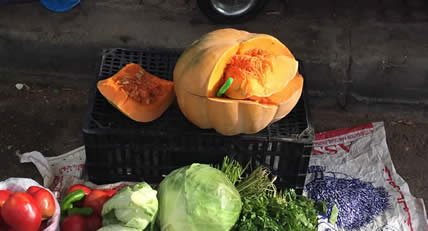
Pumpkin
|
SWEDE: will keep for ages, especially in the fridge or another cool place.
Swedes are a sort of large yellow turnip that is cultivated both for animal feed and as food for humans. Although it probably originated in Germany, it was thought in Britain to come from Sweden, hence the name. People tend to love or hate it. Traditionally accompanies haggis. It is more watery than standard turnip and needs cooking for 40-60 minutes.
American: rutabaga; Scots: neeps; German: Steckrübe. |
|
SWEET POTATOES: at room temperature. Storing in the fridge causes a hard core to develop.
French: patates douces; German: Süßkartoffel |
|
TOMATOES: not in the fridge, especially if they are unripe (if very ripe they can be put in in the fridge for a day or two to keep them, but bring to room temperature before eating as they have little taste when chilled). Will last several days out of the fridge if not too ripe.
The best way to peel tomatoes is to boil a saucepan of water sufficient to cover them. As soon as the water boils, take the saucepan off the heat and drop the tomatoes in, leaving them for 15 seconds. The skins will often come off more easily if the tomatoes have each been given one prick of a kitchen knife before being subjected to the hot water treatment.
The least sweet part of the tomatoes is the jelly round the pips. So almost all recipes involving raw tomatoes are improved if most of the pips are squeezed out. Tomato pips are designed to go through the digestive system unharmed. There is a theory that pips that have been damaged by being put through a blender or processor may cause appendicitis. There does not seem any evidence for this. But it is not pleasant to meet tomato pips roughened by the liquidizer in soup etc, so if you are liquidizing or processing tomatoes, it is best to but them through a sieve afterwards to get rid of the pips and bits of skin.
Tomatoes need real sun to develop a good flavour, so there is not much point in buying the Dutch or British polytunnel-grown ones that are on sale during the winter. For most recipes involving the cooking of tomatoes,, tinned peeled Italian plum tomatoes are better. Cherry or baby plum tomatoes tend to be sweeter than the bigger ones. If you must have tomato salad during the winter, some sugar sprinkled over the tomatoes (a Chinese trick) helps improve the flavour.
French: tomates; German: Tomaten; Italian: pomodori; Spanish: tomates; Hindi: tamatar |
|
TURNIPS: in the fridge, not in a plastic bag. As they are cabbage family, they should be cooked just long enough to be tender, as prolonged cooking increases their pungency. Older and larger turnips sometimes have a network of woody fibres just under the skin, so should be well peeled.
The leafy tops of the turnips can also be eaten, cooked like greens.
French: navets; German: Rübe |
|